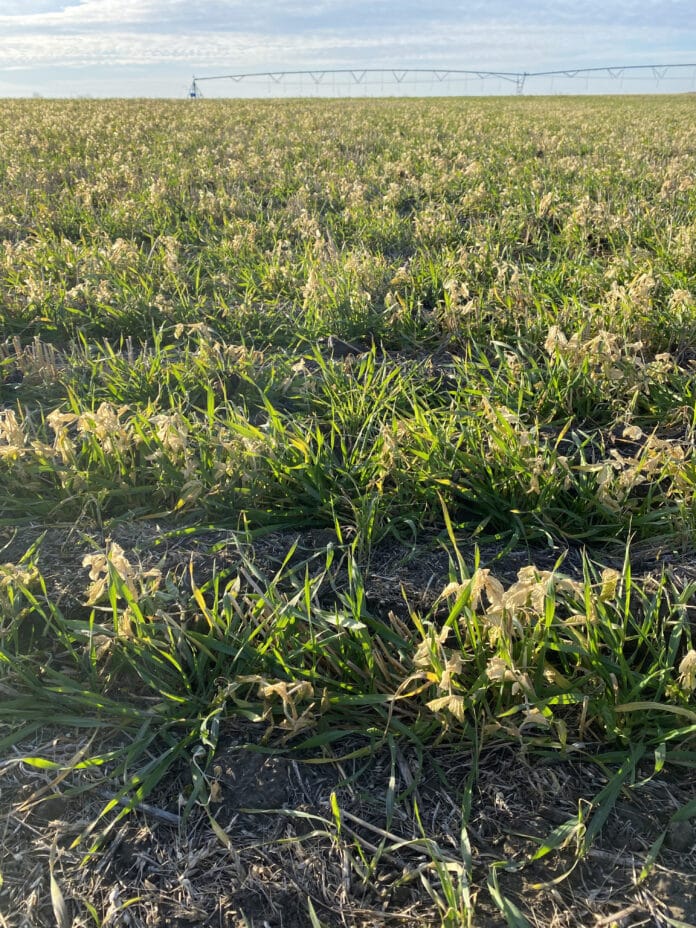At our family farm, Swansfleet, in Bruxelles, Man. quality has always been the driving force behind everything we do. Lately, that drive for quality has led us to look at what we can do to improve our soils for the long-term.
Our first regenerative practices on the farm, like many of our neighbours, was to plant shoulder season cover crops. In the fall following our potato harvest, we started planting rye on dug potato fields to reduce wind and soil erosion. This didn’t do a lot to protect the fields in the fall but covered the ground well for high winds in the spring. We’ve also spread rye on unharvested potatoes using an aerial applicator and then letting the potato harvester incorporate the seed. This reduced the amount of tillage required to establish the rye but didn’t give as nice a stand. These first conservation practices were only done to prevent erosion but as we learned later, having a green cover on the field had many other benefits.
Through talking with crop advisors and other farmers, we have learned about the soil microbiome and, the more we learned, the more interested we became in how to improve our soil health overall. We had a lot of great conversations about issues we saw in the field and what we could do to remedy them. For example, we wanted to improve drainage and structure in our soils. We farm a wide variety of soils on our farm, ranging from sand to clay loam, and some can be challenging for potato production on wet years. Improving infiltration and tilth were some of our first soil health goals. The first regenerative suggestions we got for tackling these issues were focused on cover crops.
In the last few years, we have experimented with on field-scale trials of multi-species cover crops planted ahead of potato production. The full season multi-species crops we’ve planted have included a sorghum sudan grass base with up to 10 other species such as fababeans, oats and peas. The purpose of this was to improve biodiversity and soil structure, while assisting to reduce soilborne potato diseases. Full season covers are hard to justify in today’s high commodity prices — we had to consider what we were giving up in the budget and what we were trying to potentially gain. We took this opportunity to get creative to add biodiversity without having to give up a full year rotation.
More recently we’ve started using cover crops following early season harvested cereals in rotation to maximize the amount of time we have the ground covered — in Manitoba we only have a short season to work with. Sometimes after potato harvest, there just isn’t enough time to get a viable cover crop established before freeze-up. We are looking at our crop rotation as a whole and trying to reduce tillage and increase the time we have green cover.
Our next project on the farm is to try and reduce our synthetic fertilizer usage to improve the soil structure and promote biodiversity. We are experimenting with using compost to help us reduce the amount of fertilizer needed for growing potatoes. We’re hoping to build better functioning soils that can produce similar yields on fewer chemical inputs.
Many of the long-term goals of regenerative agriculture are hard to measure. One of our biggest challenges is weighing the up-front costs of cover crops and system changes with the long-term benefits of healthier soils. It isn’t always clear what is the best decision for the farm overall. We’re trying to focus our efforts more intensely on targeted fields so we can see improvements quicker and prove the formula to ourselves. It’s easy to measure the cost of cover crop seed and the time and labour to implement the different approaches that aim to improve soil health but more difficult to measure accurately increase in infiltration or microorganisms.
For these reasons, it’s great to have McCain and the Soil Health Institute as resources to help fill in the gaps and provide support for farms that want to improve their soil health and resiliency. McCain’s Farm of the Future is also a great initiative as they’re trying out field-scale trials of different regenerative practices without farmers having to take risks on their own farms.
We’re excited to see our soils improve as we find new ways to grow our potatoes.









